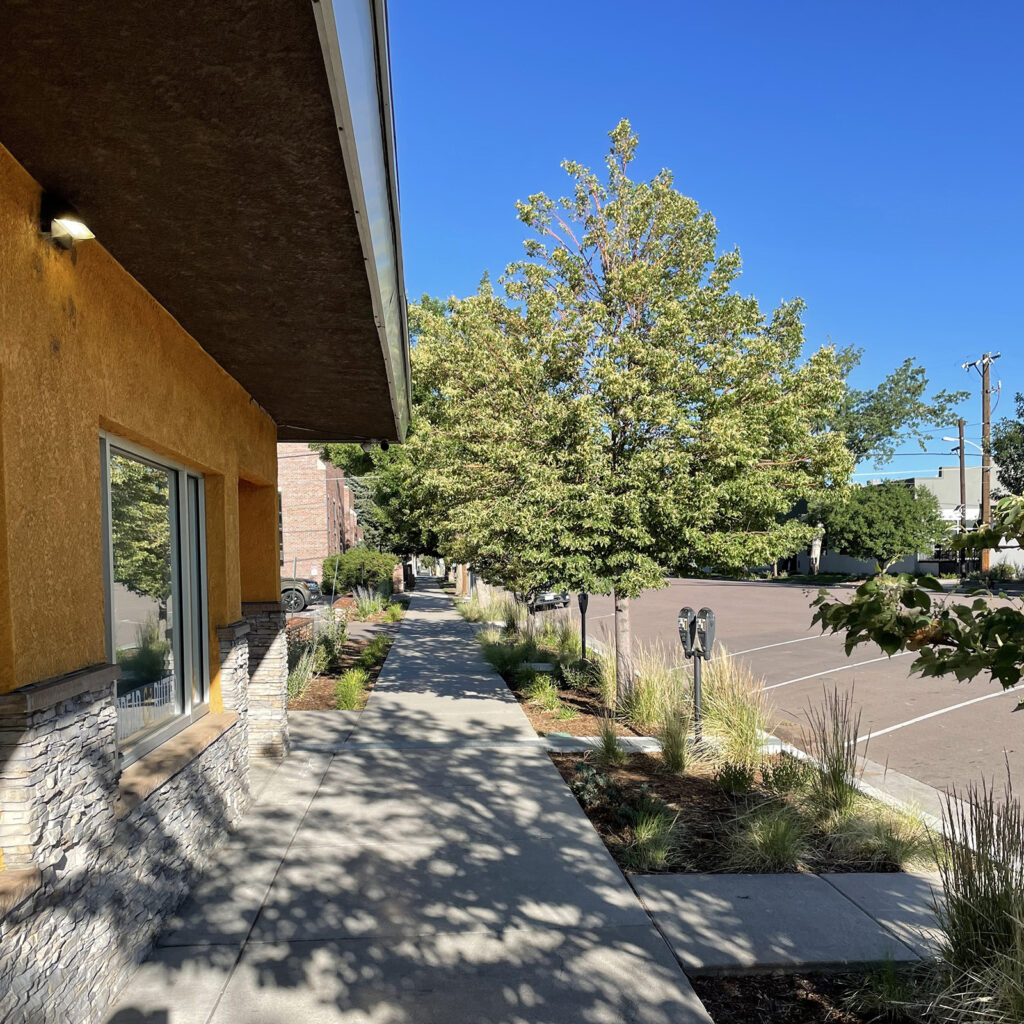The tree lawn, otherwise described as the parkway, planting strip, or even the hell strip, is the space between the curb and the sidewalk. Generally, landscape architects specify turfgrass for these hostile environments. I can’t think of a single circumstance where turfgrass should be located in these areas.
High water-use turf should only be installed where it can be utilized for recreational or passive activities, such picnicking or dog walking.
The tree lawn is not conducive for these activities due its to the proximity to traffic.
Turfgrass adjacent to the curb inevitably produces water run-off every time the irrigation runs. In Colorado, people generally irrigate high water-use turfgrass two to three days per week. That means that we are sending clean, treated water to storm sewer two to three times per week! Furthermore, many of the tree lawns installed are very narrow, four to six-feet wide is common. If lush turfgrass is still desired in the tree lawn, there is an alternative. A netafim irrigation system, a type of drip irrigation, provides water beneath the turfgrass directly to the roots. Netafim has an initially higher cost for installation, and can be difficult to maintain.
Our rivers are running dry, making this water waste unacceptable.
ALTERNATIVES TO HIGH-WATER USE TURFGRASS
Instead of using turfgrass, xeriscape principles should be applied. Low water-use plants irrigated directly at the base of the plant via a drip irrigation system is the most efficient alternative. The groundplane, beneath the plants, may include decorative rock, organic wood mulch, or 3/8” fine rock (breeze). Rock is available in a variety of colors, sizes, and textures, making it easy to complement the surrounding development.

The use of shrubs, perennials and ornamental grasses, when designed properly, is more aesthetically pleasing and certainly more responsible than turfgrass. Understandably, the upfront cost is higher utilizing plant material, however maintenance and water costs make up for this very quickly. Living in an arid desert, an argument can be made that xeriscaped tree lawns do a better job of fitting in contextually. If we weren’t so accustomed to seeing green grass everywhere, the turfgrass might otherwise appear out of place.
Before your mind takes you to removing all plant material in the tree lawn, please consider aesthetics. An artifical turf tree lawn or a rock-only tree lawn both require zero water, however are they attractive? We must consider the balance of aesthetics and conservation – a cardinal room of the triple bottom line. The aesthetic of artificial turf can be unsettling, especially in the middle of a Colorado winter. Similarly, a rock-only tree lawn requires a high amount of weed removal maintenance. The best alternative is to provide low-water use plant material, densely planted providing little room for weed growth.
Conventionally, we’ve seen turfgrass in tree lawns as the default. It’s safe to say that it’s time for a change. We hope that you will be a part of that necessary change and improve our built environment in the process.
If you would like to read more on this topic, see “Colorado River Crisis,” describing the state of our river system.


I wholeheartedly agree with your position about turfgrass and water waste. The photo of the tree lawn outside of Bread and Butter’s location is beautiful. Are there plans to reduce the excessive amount of turfgrass in the Gold Hills Mesa development?
The grass areas are mainly used by dog owners versus families as the grass is overwatered and there are no shady areas or benches. The storm water drainage area between Mayflower St and Olympian Dr, ending at Lady Campbell, was supposed to be rock and decorative grasses only, but was seeded and is now watered at least 30 mins, 5 days a week. The grass is patchy at best and extremely unattractive. With the excessive water waste, it’s no wonder there are drainage issues seen throughout the community.
If cost is an issue, then having a plan to phase in a more decorative, sustainable and economical type of landscaping should be considered. As noted in your article, initial costs are high but in the long run, it’s cheaper than planting turfgrass and using precious water resources. Also, to mitigate costs, any turf removed can be sold to other parties. Thanks.
Appreciate your comments. We are working with Gold Hill on the future developments and have indeed removed turfgrass from the tree lawns for the future development.
In regards to the existing development, we would love to see some of this get transformed over time, however it will be require significant upfront costs to do so. Thank you again!